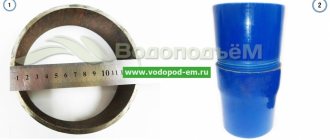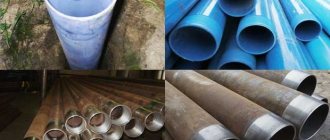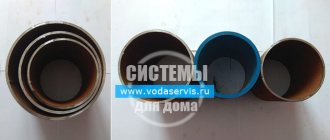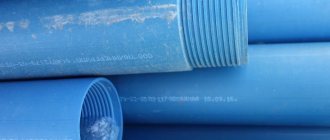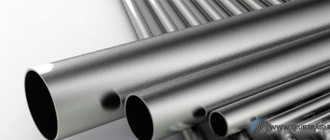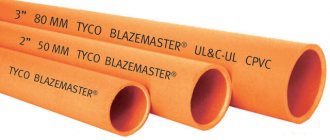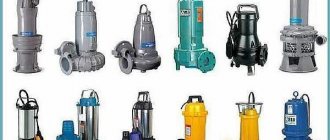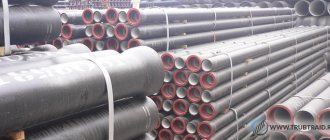For example, only in two-pipe piping systems is it permissible to double casing a well with plastic and PVC-U pipes. Popular combinations also include metal casing and polymer water-lifting pipes.
Double walls provide increased resistance to stress. If the water-lifting pipe fails, it is easy to replace. All that remains is to make the right choice of casing pipe for the well, which is not so easy from the point of view of the supply of these pipes on the market.
How to choose a casing pipe for a well
The choice of casing pipe must take into account a number of circumstances. The main criteria for choosing casing pipes are the following indicators:
- well depth;
- the type of soil in which the well is drilled;
- design loads on walls;
- pipe dimensions (diameter, length, wall thickness).
the method of its arrangement;
In addition, one must take into account the need to equip the well with additional devices, such as a head, caisson, etc.
The price factor is also important, but it should be considered under other equal circumstances. First of all, technical characteristics are taken into account.
In this regard, let us recall what casing pipes for wells are.
Myth #—Plastic is not suitable for drinking water.
This myth originated in the 90s and 00s, when the market was filled with poor quality plastic. The myth has been reinforced by the efforts of environmental organizations that seek to reduce global plastic consumption. The belief about the dangers of plastic cannot be called completely false. Cheap polymers sometimes contain substances that are hazardous to health.
HDPE pipes cannot be called completely safe. They are often made from recycled materials. The composition may contain former syringes, gasoline cans and other dangerous elements.
Types of casing pipes for water wells
The following types of casing pipes for water wells are offered to consumers:
- steel pipes;
- cast iron;
- asbestos-cement;
- HDPE casing pipes;
- from uPVC and PVC;
- made of frost-resistant polypropylene (MPP).
The use of asbestos-cement and cast iron pipes for casing a water well is quite a rare occurrence today.
Therefore, we will consider the remaining options - casing pipes for wells made of plastic and metal. If you are interested in casing pipes for wells in accordance with GOST, then it is obvious that we are talking about steel products in accordance with GOST 632-80. Plastic casing pipes for wells are produced according to specifications. For example, HDPE and PVC-U casing pipes for wells are manufactured according to TU 22.21.21.129-001-43528510-2017.
This regulatory document regulates the range of pipes by diameter, length and other indicators. Based on the date of its adoption, it can be understood that polymer casing pipes are a new material for well construction. Plastic casing pipes for a well must also meet the requirements for pressure pipes in accordance with GOST 18599-2001, GOST 18599-2001 and GOST R 51613-2000. This concerns the properties of materials, strength and special characteristics.
Steel casing pipes for wells were not created specifically for water supply, while polymer analogues are intended exclusively for this purpose. They are superior to steel products in durability, are lighter, easier to install and much cheaper. Therefore, when constructing wells, users increasingly prefer plastic.
Option #3 - steel
Black steel for casing is a classic solution. A standard part with a wall thickness of 6 mm can withstand movements of any soil and will maintain its integrity for at least 50 years. Another advantage of steel elements is their strength, which allows work to be carried out using drilling tools during operation. This way, if the pipe becomes silted, it can be cleaned. Disadvantages include instability to corrosion and, as a consequence, the appearance of rust in water. And also the high cost of such pipes.
Black steel is the best option for casing pipes. However, it is also one of the most expensive
If we talk about the feasibility of their use, then it is optimal to use steel casing for constructing wells on limestone and for deep structures. It is better not to install various variations such as stainless, galvanized and enameled pipes. Their use is justified by protection against corrosion and concern for water quality. However, galvanized steel over time begins to release zinc oxide, which is dangerous to humans, into the water.
Enameled parts are very sensitive to mechanical stress. It is practically impossible to install them without chipping. Such damaged pipes will rust into holes much faster, because their wall thickness is less than that of ordinary steel ones. Stainless steel parts are resistant to corrosion and, accordingly, do not rust in water. Considering their cost, as well as the durability of black steel and the ease of filtering out rust particles, it becomes clear that overpaying here is most likely pointless.
PVC and HDPE casing pipes: the difference
Users often ask the question what is the difference between PVC and HDPE casing pipes. These differences are due to the properties of the materials. With regard to standard sizes and options for connecting pipes into a column, there are no differences. For example, PVC-U casing pipes have a narrower operating temperature range, but are superior to HDPE pipes in strength. Therefore, PVC casing pipes are more suitable for single-pipe wells and casing of two-pipe systems, including those with greater depth.
Taking into account the operating conditions of water wells, their underground part is not subject to significant temperature changes, therefore the temperature factor does not have a decisive significance when choosing pipe material. The above-ground part of wells in cold climates must in any case be protected from exposure to low temperatures. We remind you that water freezes at temperatures below zero and a caisson is installed to protect the well from frost.
Selection of pipe diameter
So, for optimal calculations, it is worth understanding the needs of suburban real estate residents as correctly as possible. The required volume of water, pipe diameter and pump power are inextricably linked. For example, with a productivity of 3 m3/hour, a pump with a diameter of 76 mm will be required, and a casing pipe with a diameter of at least 89 mm will be suitable for it. If you need to provide 5 cubic meters per hour, then in this case the diameter of the sediment should be 102 mm, and the pipes should be at least 112 millimeters.
Why, then, in the first part of the article were other parameters for choosing the diameter of the casing pipes indicated? The fact is that experts recommend installing standard pipes, and not with a gap of 5 millimeters between the diameter of the pump and the pipe itself. In practice, such a gap will become a risk, because the pipe may move a little, and the slightest distortion in the pipe will make it difficult, if not impossible, to remove the pumping equipment from it. Therefore, remember the main pipe diameters: 133, 159 and 168 millimeters.
Casing: white or blue
The color of the pipes serves to visually identify products by the type of materials from which they are made. The blue casing pipe for wells is made of HDPE. Gray color indicates uPVC and PVC products. White casing pipes are made from MPP. To a certain extent, color indicates operational parameters, but the main criteria for choosing casing pipes are the following characteristics:
- diameter in the range of 80–400 mm;
- wall thickness in the range of 4–21.5 mm;
- length in the range of 2–6 m;
- connection method - nipple, coupling, socket.
All connection options listed are threaded. The nipple method of assembling columns is provided by internal and external threads at the ends of the pipes. Such a connection does not change (increase) the diameter of the column. The coupling connection is carried out using an overhead coupling, which is screwed onto the ends of pipes with external threads, thus increasing the diameter of the column.
The socket connection combines the principle of nipple and coupling assembly. The flared end has an internal thread into which another pipe with an external thread is screwed. This connection method also increases the diameter of the column, but to a smaller extent than what happens when assembled on couplings.
Methods for connecting casing products
Often casing pipes consist of segments that are connected to each other in one of the three specified ways.
- Welding.
- Fittings, thread.
- Trumpet.
In order to find out which connection method is better, let's remember what the main function of the casing is. That's right, maintaining tightness. Therefore, the best connection method is threading. When welding, everything depends mainly on the work of the welder, but there will be a lot of seams, which means there is a high probability that at least one of them will be of poor quality. Moreover, welding seams are a kind of catalyst for the appearance of rust, so the service life of the structure is reduced. When the tightness of the weld is broken, the pipe can move, which is why earth can get into the column and block access to the submersible pump.
Threaded connection
The socket is not reliable from a physical point of view, because when installing pipes you will not be able to control the process, and subsidence can occur after just a few years of operation.
Which casing pipe is better for a well?
When asked which casing pipe is better for a well, they usually mean contrasting steel and polymer pipes. The metal casing pipe for a water well has already stood the test of time. It is reliable and durable, but the construction of such wells is expensive. In addition, you don’t have to think about choosing a pipe - as long as it fits in size.
The choice of polymer casing pipes is more complex, but the result is worth it. In most cases, plastic products can easily replace steel pipes. In terms of durability, they will surpass their metal counterparts, and in terms of money they will cost you much less. If you are in doubt about which casing pipe is best to use for a well, try the combined option.
For two-pipe wells, a metal pipe casing can be used in combination with a plastic water-lifting pipe. This solution is very popular among people who doubt the capabilities of plastic. In addition, it will cost you less than a pure steel option, but more expensive than a well made of polymer pipes. However, when it comes to choosing metal or plastic for well casing pipes, the future belongs to polymer materials.
Myth #—Plastic casing can collapse
The myth arose due to another psychological technique: generalization of information. The described defect is typical for plastic pipes with metal reinforcement. As temperatures fluctuate, steel and plastic expand and contract at different rates.
Due to uneven deformation, microcracks appear in the walls. When water gets into them, it forms condensation. Swellings appear that do not affect the operation of the system. If the described defect occurs in a hot water supply system, the pipeline may collapse.
There is no reinforcement in the design of uPVC pipes. The casing consists entirely of plastic. Only cold water rises up the casing. Collapse is physically impossible.
We guarantee the absence of microcracks and other defects on the pipes. For casing, we purchase materials from. Products manufactured at the Yaroslavl plant comply with international standards.
Casing wall thickness
The question of what wall thickness to choose for the casing pipe is relevant when constructing a well from plastic pipes. It must be calculated based on the depth of the well and the type (group) of soil. For wells up to 30 m deep, pipes with walls up to 7.5 mm thick are usually sufficient. There is still 14 mm of wall thickness left, which is enough to construct wells with a depth of 100 meters or more. Each standard size of steel pipes has 4–6 wall thickness options, but in the case of water wells, the minimum value of this indicator is enough.
An effective filter must meet the following requirements:
- ensure access of water to the well, while reliably protecting it from collapse of water-bearing rocks and sanding;
- in wells used for drinking water supply, the filter should help maintain water quality;
- the material of the product must be resistant to corrosion;
- be durable, which will allow it to withstand the pressure of the filtration flow, rock pressure and resist abrasion (abrasive) by rock particles;
- the design of the device must be technologically advanced and applicable in a wide range of hydrogeological conditions;
- in addition, it must have good technical and economic indicators.
All the above requirements are met by the PVC-U well filter offered by us.
